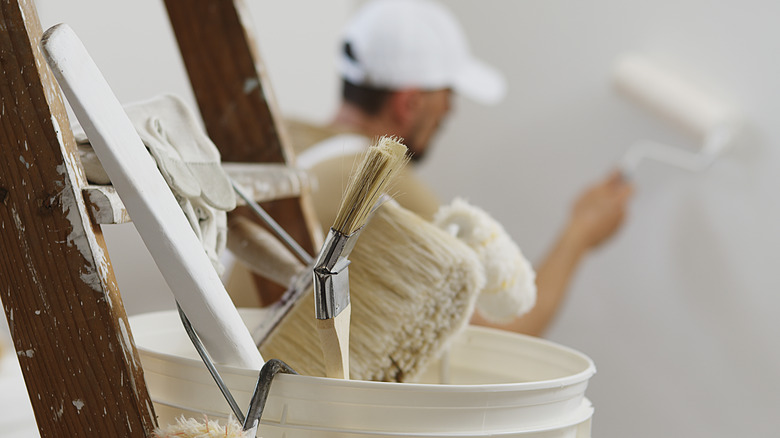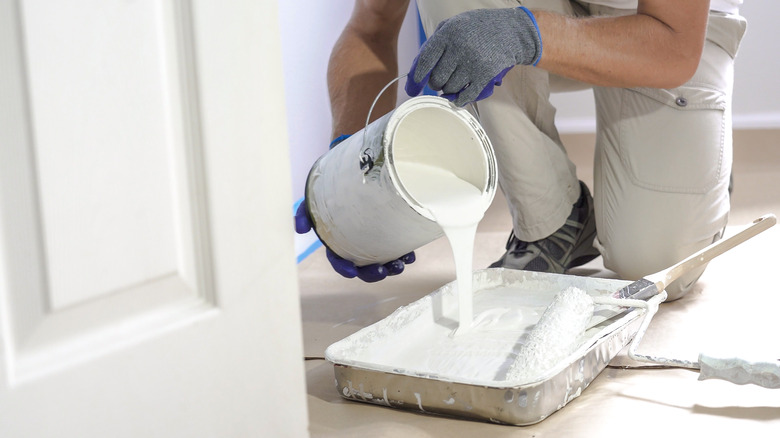How To Know If A Painting Company Is Taking Advantage Of You
Painting offers a great opportunity to transform the aesthetic of your home. PaintRite Pros suggests repainting the interior of your home every three to five years. CertaPro Painters estimates that exterior jobs should be conducted every five to 10 years, depending on a number of environmental factors and the quality of the paint that was used during the last job.
But with the continuous need to repaint and refresh the home, there comes a decision. You can paint the walls yourself — saving money, but trading these savings for a considerable amount of dedicated work — or hire a professional to take the hassle away from you. Painting professionals are great assets for homeowners that might not know what color they want to change their walls to (either interior or exterior). Painters offer a sounding board and a level of expertise that homeowners can't take advantage of when painting on their own. Likewise, professionals make the job far easier: They perform the painting in a much quicker timeline and take the burden of the prep work and painstaking task of painting away completely.
With the reliance on painters at such a high, it's important to remember that service providers of all types can give you great service and a high-quality experience, or talk a big game and then rip you off. Painters that approach the job with the qualities below should be avoided at all costs to ensure a smooth paint job and fantastic experience.
Questions arise in contract language
Looking out for loose language in the contract or parsing imprecise claims during the consultation process can help you make a better decision when selecting a painter. Painting isn't just the process of applying new color to a wall. This job involves preparation of the wall and the room, the application of a primer coat, and many other nuanced tasks (via PG Paint and Design). If your contract doesn't specify all the things that your painter should be doing, there's a chance that they won't get done at all. Even worse, it's possible that your painter will arrive on the day of the job only to explain to you that prepainting work must be done and because it's not in the contract, it will cost you extra!
With any job that you hire a contracted worker to complete, it's essential to hammer out all the details before signing a contract or paying for the work to be completed. Painters and other contractors typically aren't out to bilk their clients, but that doesn't mean that you can trust every person in the industry that you come across. Putting the terms in a contract that's clear and comprehensive is the only way to protect both yourself and the painter alike.
Paint quality tricks
A painter that is taking advantage of you may try to pull a paint quality switch on you. This is the process of upselling (or agreeing to use higher quality paints) and then failing to deliver on the agreed-upon paint type or brand. Paints come in a wide range of styles, sheens, and qualities to go along with the veritable rainbow of color choices. A painter that is looking out for their own interests at your expense will agree to purchase a certain type of upgraded paint, and then sneak in a lower quality option in order to pocket the difference in price, according to PG Paint and Design.
PG Paint and Design notes that a great way to identify this scam is to inspect the paint cans and any other painting supplies that your painter brings to the job site. To pull off this bait and switch, a painter will need to continuously refill the cans that show the correct label on them. In order to accomplish this, there will be telltale signs of pouring one container into another, with splashes and drip marks across the can. Likewise, if your painter is repeatedly taking away paint cans when it comes time to fill up the tray (rather than just grabbing a new can), you may be looking at a refill job, or even the process of watering down the paint to create a larger volume at the expense of your walls and wallet.
Paint volume discrepancies
Another potential sign of a poor-quality paint job is the use of too little paint. Your painter may try to get away with buying the bare minimum in terms of volume and then stretch the paint to its maximum utility. This shows through visible staining, flaws, or slight color changes across the wall (per Home Reference).
Visible stains, discoloration, fading, or the presence of damage on the top or even beneath the newly added color indicates the use of a single coat of paint, or a very light second coat that wasn't sufficient to appropriately finish off the job. Painters may try to get away with this in order to reduce their expenses as much as possible.
Alternatively, a painter may purchase too little paint, and then come back to you to demand more cash in order to rectify the situation. This is done after the painting has already started, making you feel as if you have no choice but to comply. The best way to circumvent this potential issue is to ensure that everything is spelled out in a written contract. If your contract stipulates the use of primer and two coats, then try as he might, your painter has no recourse to pull this con on you and demand an additional round of payment to cover the cost of additional supplies.
Room preparation is largely the painter's job
Some of the preparation work falls to the homeowner. Removing expensive, sentimental, or other important belongings is a crucial step to getting the painting done right. These belongings are best cared for by you, and no one else. You might also want or need to move couches and other large items of furniture before your painters arrive (although you should discuss this with them before the job starts). The rest of the preparation work falls on the painters themselves, according to Bear Mountain Painting.
Setting drop cloths around the room, taping corners, edges, and other elements in the rooms they are working on, and cleaning the walls before they open even a single can of paint is a sure sign of a job that will be done well. If your painter doesn't begin the job by preparing the room for the mess that will surely come along with the process of painting, you're likely working with a fly-by-night operation. These are integral steps in the process of a professional paint job and should never be skipped. Painters that don't prepare the room are ones that shouldn't be counted on.
This goes for dings and dents in walls as well. A good painter will take the time to identify any issues in the drywall and remedy them before applying the first coat (via PG Paint and Design). This ensures a smooth finish and a wonderful shine across the entire surface.
Your painter skipped the typical color consultation
A color consultation is an often overlooked component of the painting process. Painters with great reputations always include this step in their service. In truth, this phase of professional painting services is one of the key assets that sets apart a professional job from a DIY one. Painting professionals spend their days looking at and preparing walls for new paint. They are constantly in contact with old color schemes and new ones. This makes painters the perfect expert to rely on when selecting a new color scheme to incorporate into your home (via Bear Mountain Painting).
The color consultation provides homeowners with a much-needed riff session with their professional painter. Here, you can ask any questions about paint finishes, color combinations, or the process of preparing, priming, and painting itself. If your painter didn't offer a color consultation, it's possible that you're working with a less than stellar painting outfit that might not perform a fantastic job on your home's walls. You should, therefore, always ask for this meeting, even if you don't have much to discuss. In this instance, a consultation can act as a litmus test of sorts to evaluate the openness and helpfulness of the painter. If your painter refuses to schedule a color consultation, it's probably time to look elsewhere for this service.





